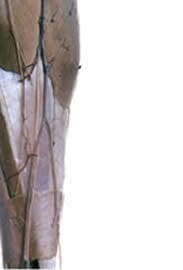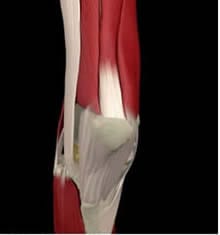ILIOTIBIAL BAND (ITB) FRICTION SYNDROME
Fascia is a sheet or band of fibrous connective tissue which extends uninterrupted from our head to the tips of our toes. It surrounds muscles, groups of muscles, blood vessels and nerves, binding some structures together, while permitting others to slide smoothly over each other. Various kinds of fascia exist depending on the anatomical location, such as superficial fascia, deep fascia and visceral (fascia surrounding organs) fascia.
Picture of Fascia:

For many years, anatomists discarded fascia and purely looked at the function of muscles at an individual level, defining a muscle’s function solely by what happens as a consequence of the proximal and distal attachment sites approximating. It has now come to light, through the work of authors such as Thomas Myers, that the complexity of movement and how impairment of movement in one body location can have a large impact at a distal site. As the song says, “the leg bone is connected to the knee bone”, etc.
The iliotibial band (ITB) is a wide layer of fascia located on the outer part of the thigh (lateral), which extends from the gluteal fascia over the lateral quads and funnels into a strong cable along the side of the knee, before inserting onto a bony protuberance of the tibia.

SYMPTOMS
The ITB is particularly prone to injury in runners and is the leading cause of pain on the outer/lateral aspect of the knee in these athletes (Noehren et al, 2007).
This pain often occurs in endurance runners and is felt as a sharp or burning pain on the outer aspect of the knee. Initially, this pain only occurs with running (especially downhill), but chronic injury can lead to pain with walking and going up- and down-hill.
The pain itself occurs as a result of friction of the ITB over the lateral femoral condyle. Many causative factors have been suggested to contribute to the development of this complaint, including poor running techniques, bow legs, hyperpronation of the feet and weak hip abductors.
Noehren B, Davis I, Hamill J. (2007) ASB clinical biomechanics award winner 2006 prospective study of the biomechanical factors associated with iliotibial band syndrome. Clin Biomech (Bristol, Avon). 2007 Nov;22(9):951-6. Epub 2007 Aug 28.
Fredickson, M., Cookingham, C.L., Chaudhari, A.M., Dowdell, B.C.,Oestreicher, N., Sahrmann, S.A., 2000. Hip abductor weakness in distance runners with iliotibial band syndrome. Clin. J. Sport Med. 10, 169–175.
(The list of conditions given above and subsequent explanations are intended as a general guide and should not be considered a replacement for a full medical examination. Furthermore, we do not purport to treat all the conditions listed. Should you wish to discuss any of these conditions with our chiropractors, please do not hesitate to phone the clinic on 020 7374 2272 or email enquiries@body-motion.co.uk).
Our team of chiropractors and massage therapists are on hand to answer any questions you may have, so get in touch today via enquiries@body-motion.co.uk or on +44 (0)20 7374 2272.
Get Seen Today – Check Availability Now
